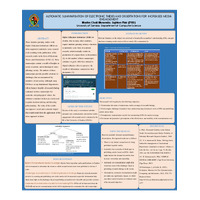Automatic Summarisation of Electronic Theses and Dissertations for Increased Media Engagement
Metadata
Automatic Summarisation of Electronic Theses and Dissertations for Increased Media Engagement
Higher Education Institutions (HEIs) regularly publish manuscripts of academic research which provide useful insights into social, economic and technological issues affecting society (Phiri & M’sendo, n.d.). In the Electronic Theses and Dissertations (ETDs) researchers often provide focus on impact-driven research that has the potential to inform policy direction. However, due to the large size of these ETD manuscripts, important stakeholders, such as local mainstream media outlets, find it difficult to synthesise the content of these manuscripts. A potential solution would be to take advantage of advances in Artificial Intelligence by using Natural Language Processing (NLP) techniques to summarise the ETDs. Automatic text summarisation as Allahyari defined it, is the task of producing a concise and fluent summary while preserving key information content and overall meaning. The text summarisation techniques can be employed to generate snippets of scholarly research output that is concise and easy to assimilate by non-technical persons. (Allahyari et al., 2017; Ingram et al., n.d.). Existing literature broadly categories automatic summarisation into two broad classes: abstractive summarisation and extractive summarisation. This study seeks to understand the challenges with synthesising ETD and design and implementation of software tools to be used to automatically summarise ETDs with a focus on mining text data and designing tools that allow for the automated summarisation and modification of the text, using usable tools.
2024

